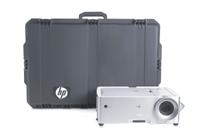When you want to have people clearly understand the big picture, nothing helps like having a big, clear picture'literally'to show them.Fortunately, the presentation equipment you need to show the big picture is getting cheaper, improving in picture quality and easier to use.It's also getting more popular. According to Pacific Media Associates of Menlo, Calif., a research firm, the U.S. market for front-screen projectors grew 34 percent last year, with 1.1 million units sold compared to 840,000 the year before. It's expected to expand another 35 percent to about 1.5 million units this year.Plasma and LCD TVs showed even faster growth. Plasma-display sales have more than doubled in the recent years as have sales of LCD TVs.There is a difference between these two broad categories. With projectors, 90 percent of the sales were professional sales in the government, education and business markets.Cables have always been the bane of smooth presentation. Going back to the days of slide shows, this meant standing close enough to the projector to operate a wired remote, or if you wanted to be at a podium or close to the screen, hoping an assistant would get the cues right.Notebook PCs similarly require the presenter to stay close enough to hit the PowerPoint presentation cues. They also limit presentation delivery to the person who is connected.Recently, however, several developments have made it easier to work untethered. One is the growth of wireless connections, which let anyone in a meeting hook into the projector without having to switch places and cables.For instance, InFocus Corp. of Wilsonville, Ore., offers a system called LightShow'a wireless adapter and PC Card'that works with its own projectors and those from a dozen other manufacturers.And Christie Digital Systems Inc. of Cypress, Calif., has just introduced ChristieNET Wave, a wireless extension system that links computer-based audio and video sources.The Cintiq interactive pen display from Wacom Technology of Vancouver, Wash., is another option. These tablets with electronic pens can be linked into a projector for live interaction with the displayed document. They can be passed around a conference table, allowing participants to make changes or add notes.For larger presentations, the speaker can leave the Cintiq on the podium or carry it around the stage, making notes or pointing out parts of the display without ever turning his back on the audience.Projectors also can get their images from handheld PCs. Margi Systems Inc. of Fremont, Calif., has a product called Wireless Presentations to Go, which connects Palm or PocketPC devices to a projector using an 802.11b connection.Finally, some projectors let you insert a CompactFlash card containing the presentation so that no additional computing device is needed.Another development to watch for this year is Hewlett-Packard Co.'s release of 'wobulation' technology in its Digital Light Processing projectors. This technology is a method of doubling the resolution without increasing the number of pixels, producing better-looking images without greatly increasing the complexity and size of the hardware.Wobulation technology works by taking the original frame of data and generating multiple subframes from it. It then uses an optical-image shifting mechanism to displace the projected images of these subframes by less than a pixel. These subframes are projected in rapid succession, appearing to be a single image. As a result, the projector doubles both the horizontal and vertical resolution of the image. A later version will offer four times the resolution.Although interactive whiteboards have been around for 15 years and are considered a mature technology, they also continue to develop. For example, in January Smart Technologies of Calgary, Alberta, released two new wireless tools to extend the use of its whiteboards. Its LinQ software lets any networked computer, including wireless notebooks, access the whiteboard.In a classroom setting, for example, a student could link to the whiteboard, and then go up to it to make the presentation, remotely controlling the notebooks through the whiteboard. At the same time, Smart also released a 6-by-8-inch Bluetooth slate that can be passed around to let meeting participants or students access the whiteboard from their seats.Given the range of display options now available, the common question is which is best for what types of applications. Any of them will do the job, but each has advantages in certain areas. Here is some advice on a display technology from Steve Secrist, an analyst for Insight Media of Norwalk, Conn.:Digital light processing vs. LCD. Either one is a proven reliable technology, but there are some differences. DLP projectors are generally preferable for mobile applications. They only contain one imaging device and so are lighter and won't go out of alignment if handled roughly. DLP also has the advantage of a higher contrast ratio.LCD, on the other hand, is generally considered to have better color quality, and is more popular with permanent installations where weight is not an issue.'Both are really proven technologies. If you are planning on traveling you may want to consider DLP,' said Secrist. 'But for conference rooms, LCD projectors contain three microdisplays, which make for a richer color set than the single microdisplay in a DLP.'Plasmas vs. LCDs. Plasmas tend to be larger, cheaper, have better contrast ratios and have a shorter response time so moving images don't smear. LCDs have better resolution, consume less power and don't need a cooling fan like plasmas.Projectors vs. monitors. LCD and DLP screens offer a good-looking picture, even in ambient light. With LCDs, you also don't have fan noise like you do with projectors. Disadvantages include much higher cost and a fixed image size. Monitors are also much more expensive than a projector of comparable image quality. Because of the cost, they are usually limited to high-end boardroom settings.'When looking at the price difference between a projector and a fixed-pixel device like a plasma, it is hard to justify spending the extra money,' Secrist said.
HP's xp8010 digital projector offers 2,800 lumens brightness and sells for $2,599.







